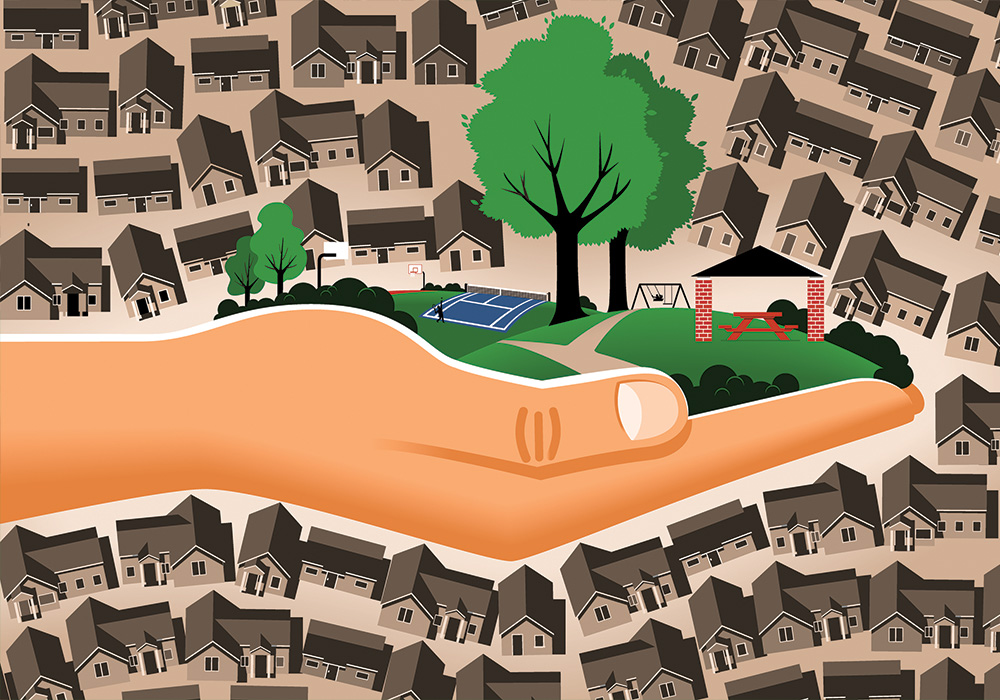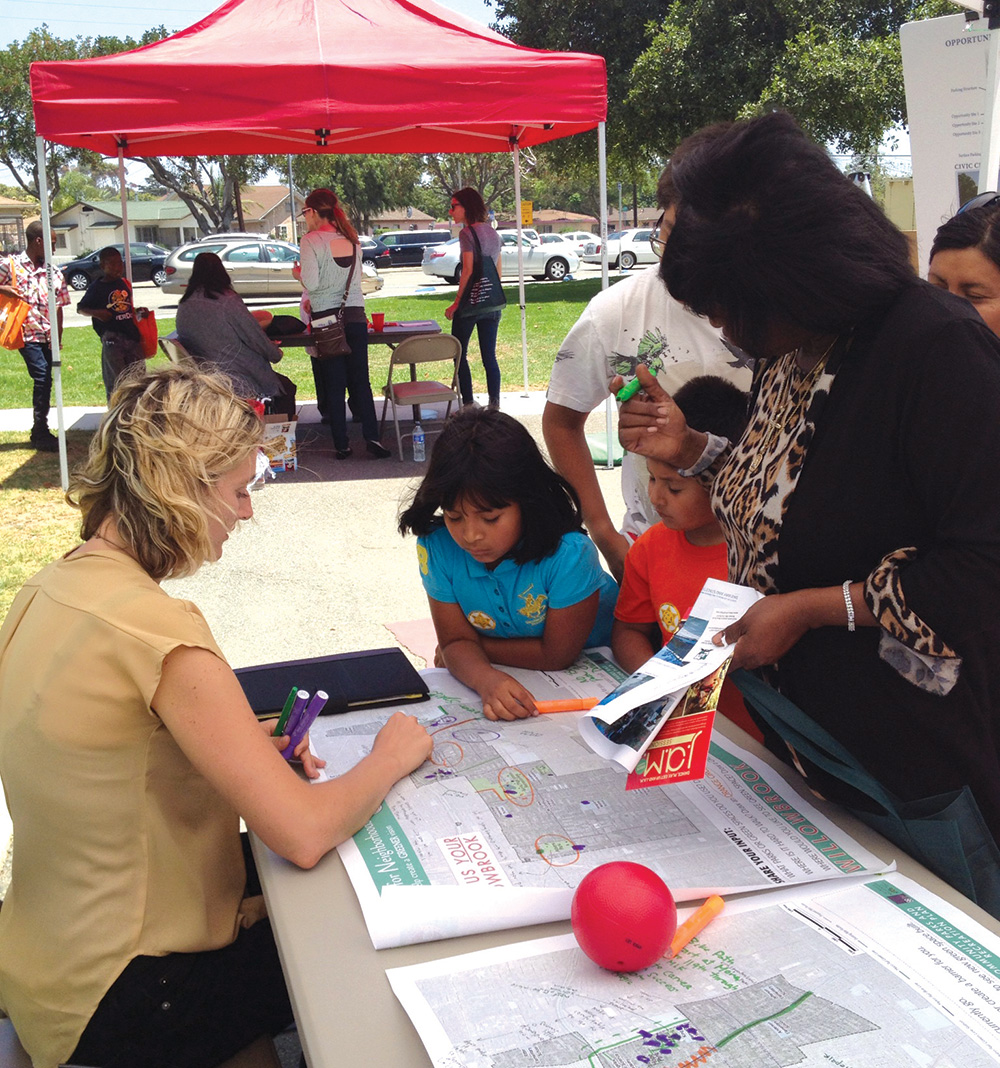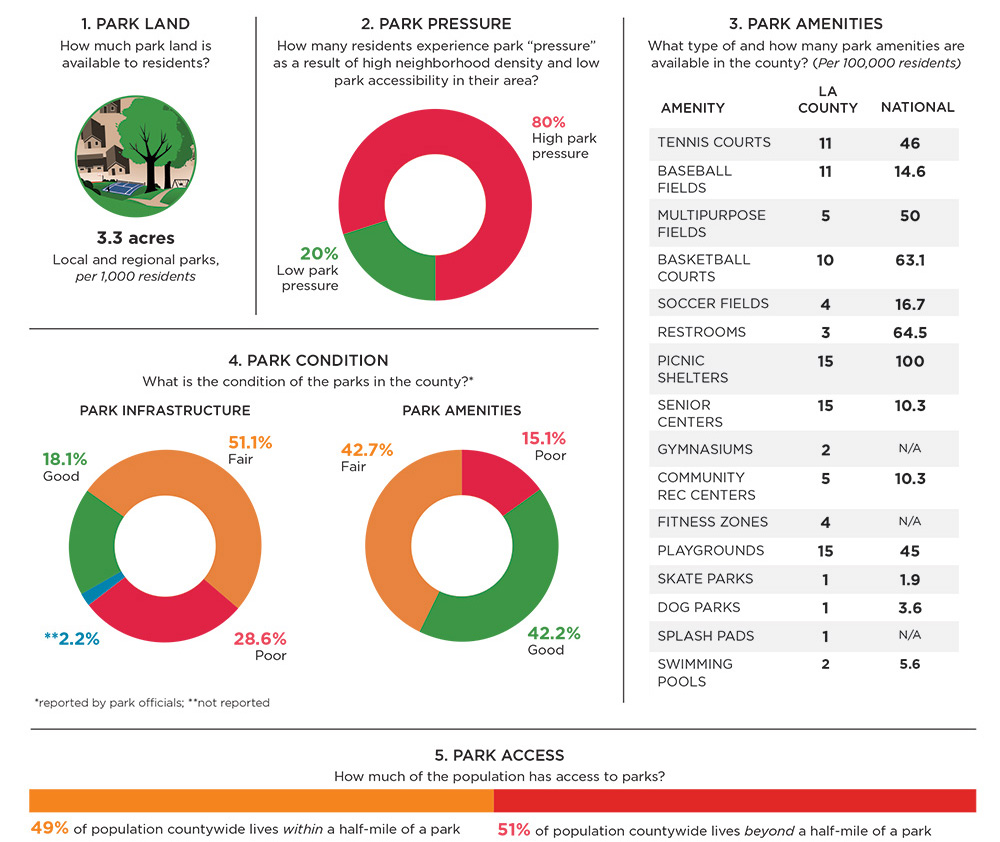Planning November 2017
Nurturing Neighborhoods
Making urban parks sustainable and equitable delivers benefits well past their edges.
By Clement Lau
There are more than 3,000 parks in Los Angeles County. Some are managed by the LA County Department of Parks and Recreation. Others belong to the park systems of the 88 cities inside the county's 4,084 square miles. Still others are state and federal parklands. All in all, park and open space covers more than 901,000 acres.
But some communities are critically lacking in parks. A few years ago, LA County launched a master planning effort for a slice of that underserved group, creating plans for six of its most park-poor unincorporated communities. That effort set the stage for much bigger things, including the county's first wide-ranging evaluation of parks countywide and the passage of a funding measure that will generate about $94 million annually. It also has helped the county see parks through a lens of sustainability.
It all started in 2012, when DPR applied for a Sustainable Communities Planning grant from the California Strategic Growth Council to prepare the first phase of the Master Plan for Sustainable Parks and Recreation. It won that $1 million grant, despite being up against planning and transportation agencies with more experience in competing for such funds — and completed the Master Plan in 2016. Aiding in the effort were residents, community-based organizations, other county departments, and the consulting firm PlaceWorks.
"This exciting work was really to bridge sustainability, social equity, and park issues together," says Norma E. Garcia, chief deputy director of DPR, in an interview with the Southern California Association of Governments in April 2017.

Illustration by John W. Tomac.
That plan wound up being a stepping stone for the Los Angeles Countywide Comprehensive Parks and Recreation Needs Assessment, which involved all of the cities and unincorporated communities in the county. Built upon the analytical approach of the Master Plan, it represents a historic undertaking to engage all of Los Angeles County in a collaborative process for future decision making. Its primary goal "was to quantify the magnitude of need for parks and recreational facilities and determine the potential cost of meeting that need," as John Wicker, the director of DPR, explained in his presentation to the LA County Board of Supervisors in May 2016.
It focuses on sustainability, and establishes a new way to understand and think about parks, recreation, and open space by considering parks as key infrastructure needed to maintain and improve the quality of life for all county residents, using a new series of metrics to determine park needs, supporting a need-based allocation of funding for parks and recreation, and emphasizing both community priorities and deferred maintenance projects.
The needs assessment was finished ahead of schedule and its findings were so compelling that the Board of Supervisors decided to put a parks funding measure, Measure A, on the ballot in November 2016. Due in large part to the extensive community engagement process for the needs assessment and the effective dissemination of public information, Measure A was passed with nearly 75 percent of voters supporting it.
Multiple Benefits
LA County's Community Parks and Recreation Plans deliver community benefits beyond each park's border.
Environmental
- Improved air quality
- Stormwater management
- Heat island mitigation and temperature stabilization
Social
- Improved public health
- Improved community safety
- Enhanced community cohesion
- Improved walkability
- Stress reduction and improved academic performance
Economic
- Energy conservation and green infrastructure
- Increased property values
- Increased activity in retail areas

Community members in Willowbrook participate in an outreach fair and vote for their favorite park amenities. Photo courtesy Los Angeles County Department of Parks and Recreation.
Planning for park-poor places
Back to where it all started. Phase I of the Master Plan consists of Community Parks and Recreation Plans for six of the most park-poor unincorporated communities in LA County: East Los Angeles, East Rancho Dominguez, Lennox, Walnut Park, West Athens-Westmont, and Willowbrook. Collectively, they are home to about 257,000 people, or about a quarter of the population living in the county's unincorporated areas. (The project is called Phase I because DPR anticipates preparing similar plans for other unincorporated communities.)
Each Community Parks and Recreation Plan begins with an examination of local demographics, existing parkland and recreational facilities, parkland gaps, current recreation programs, trees, transportation and connectivity to parks, and availability of land for new parks. This baseline information, together with public input, informs a detailed assessment and prioritization of local park needs.
This, in turn, guides the development of a green space vision, conceptual designs of potential new urban park and trail projects, and specific strategies and implementation actions to address the identified needs, with the overall goal of making communities more sustainable through a variety of park and urban greening efforts that offer wide-reaching benefits and impacts.
"We really looked at not just opportunities for park development, but also opportunities to enhance livability, to improve health outcomes, to improve sustainability and environmental outcomes, and to improve infrastructure like parks," says Garcia.
The New Paradigm
LA County's Master Plan for Sustainable Parks and Recreation focuses on sustainability, and establishes a new way to understand and think about four important goals:
- Considering parks as key infrastructure needed to maintain and improve the quality of life for all county residents
- Using a new series of metrics to determine park needs
- Supporting a need-based allocation of funding for parks and recreation
- Emphasizing both community priorities and deferred maintenance projects
Focus on sustainability
While traditional park master plans typically focus on parks and recreational facilities only, the CPRPs also seek to achieve broader sustainability goals — an aim that will be an integral part of future park planning efforts throughout the county.
Community members in Willowbrook participate in an outreach fair and vote for their favorite park amenities. Photo courtesy Los Angeles County Department of Parks and Recreation.
ADDRESS CLIMATE CHANGE. The CPRPs, when the highest priority projects are implemented, will result in 14 new parks (70 acres in all) closer to where people live (within a half-mile of most residences). That will help decrease vehicle miles traveled and greenhouse gas emissions. The plans also encourage alternative modes of transportation, and propose amenities like new bike racks and crosswalks.
The plans also call for solar panels and other onsite energy production facilities and electric vehicle charging stations.
Robust tree-planting programs help to sequester carbon as much as 13,000 metric tons a year, which is more than double the capacity of the urban forests in those six communities today.
PROMOTE ENERGY AND WATER EFFICIENCY. DPR understands that changes to maintenance and landscapes within existing and future parks can provide dramatic water conservation gains. Smart controllers will be able to adjust irrigation frequency based on weather conditions, and DPR is also replacing plumbing fixtures and using recycled water for irrigation.
The plans quantify estimated savings, in gallons per year, for sample park projects. Key strategies include using drip irrigation instead of spray heads, 16 percent; planting low-water-use plants (and replacing thirsty ones), 62 percent; and using mulch to retain soil moisture, 20 percent.
The plans also address energy efficiency, recommending installing solar panels in exposed parking lots or on building roofs, using paving materials with low reflectivity to reduce surface temperatures, and building and rehabilitating park buildings to LEED standards.
ENSURE ENVIRONMENTAL JUSTICE. Phase I of the Master Plan focuses on six park-poor, low-income communities, where the vast majority of residents are African Americans and Latinos. The CPRPs propose strategies to improve residents' quality of life and demonstrate how high-priority park projects could improve service delivery.
In East Los Angeles, for instance, the proposed addition of nearly 19 acres of new parkland would put 21,000 more residents within walking distance of a park, and would serve 7,000 more youths.
PROVIDE ACCESSIBILITY. A key goal of the CPRPs is to make parks highly accessible to residents, particularly those without a car. They call for DPR to collaborate with the Department of Public Works to improve pedestrian and bicycle access to parks, and provide shuttle-bus services to connect parks with other community destinations like schools, libraries, and shopping centers.
IMPROVE HEALTH. New park and trail projects would allow more residents to walk, bike, and exercise more regularly, and those outcomes, as well as other public health benefits, are a big part of the plans. The Department of Public Health is an important partner in these efforts.
"We know that parks are good for public health — [that's] sort of intuitive," Paul Simon, MD, the chief science officer with DPH, said when he addressed the Board of Supervisors last year in support of the Parks Needs Assessment. "But there's also quite a large research database that supports this, that having proximity and access to parks makes it much more easy for people to be physically active."
The 5 Park Metrics for Los Angeles County
Park need is traditionally measured with a single metric, such as the number of acres of park land available to residents, or the percentage of residents living within walking distance of a park. Measuring only a single aspect of need provides only a one-dimensional understanding. The Los Angeles Countywide Comprehensive Parks and Recreation Needs Assessment examines many variables, using five metrics to produce a comprehensive view.

Sources: Los Angeles County Department of Parks and Recreation and Placeworks
Getting it all done
Is this just another planning exercise? Will we actually see any improvements or new parks built? These questions were often asked during the outreach process.
In fact, implementation of the CPRPs is already under way with a multitude of projects at varying scales: surveillance cameras to address safety concerns, upgrades to sports fields and lighting, replacement of irrigation systems, and development of a new demonstration garden, educational interpretative signage, and site furnishings.
A notable effort, the first phase of the Earvin "Magic" Johnson Park Master Plan implementation project in Willowbrook will redevelop 11 acres of the 126-acre park, adding a new event center, wedding pavilion, biofiltration areas, children's play areas, parking, and a system that uses recycled water from wet and dry weather flows to maintain the water level in the two existing lakes and for irrigation through the entire park.

Rendering courtesy Los Angeles County Department of Parks and Recreation and Placeworks.
Given the limited availability of vacant land, the CPRPs take an innovative approach to new park creation. Here are some of the new public spaces proposed:
AN EIGHT-ACRE COMMUNITY PARK (rendering above) located within a utility corridor in East Los Angeles that would offer decomposed granite walking paths, open fields, gathering and picnic spaces, natural play spaces, and exercise nodes in an area currently lacking such amenities.
A NEW EXERCISE TRAIL to be located on a slope and currently underused area of an existing park in East Los Angeles that would include stairs and offer pedestrians a new entry point to the park.
A BUTTERFLY-THEMED PARK PLAZA to be developed at an existing library in West Athens- Westmont that would provide an outdoor reading area, play equipment, and exercise stations.
A NEW HALF-ACRE POCKET PARK to be built in a currently park-less neighborhood in West Athens- Westmont along a major bus route.
And how to pay for it all? Measure A, the parks funding measure passed in November 2016, will help when its funding starts to become available next year. It has special provisions for high-need communities as defined by the Countywide Parks Needs Assessment.
Parks and recreation planning is more than just fun and games. Parks contribute significantly to the quality of life for all, deliver a wide range of benefits beyond their borders, and hold immense potential for advancing sustainability in communities.
Clement Lau is a departmental facilities planner for the Los Angeles County Department of Parks and Recreation. He was the project manager for the Master Plan for Sustainable Parks and Recreation and the Countywide Parks Needs Assessment.
Resources
Los Angeles County Community Parks and Recreation Plans: goo.gl/N7lb6o
Los Angeles County Parks and Recreation Needs Assessment: lacountyparkneeds.org
"Parks and Public Health in Los Angeles County" report: tinyurl.com/yba7fdpu
Sustainability Awards 2017: Los Angeles County Parks: The parks department has won several awards for its sustainable Master Plan, including the Green Region Initiative Award from the Southern California Association of Governments. vimeo.com/216757225


